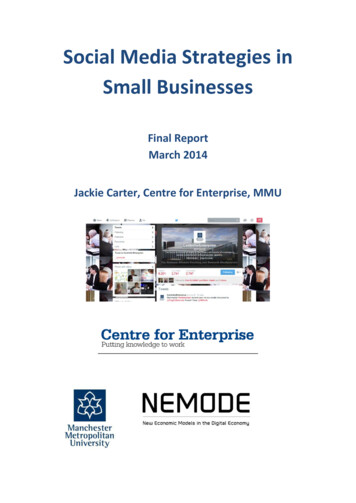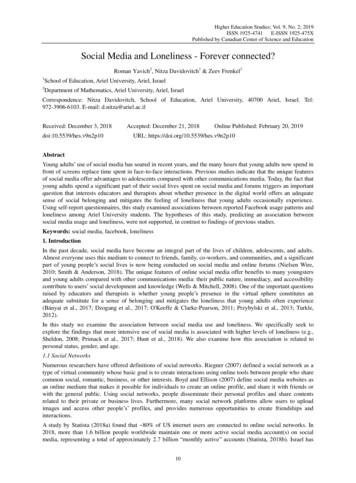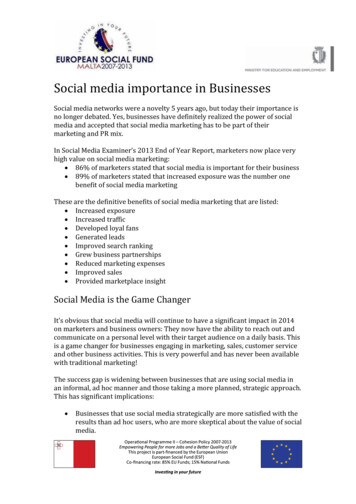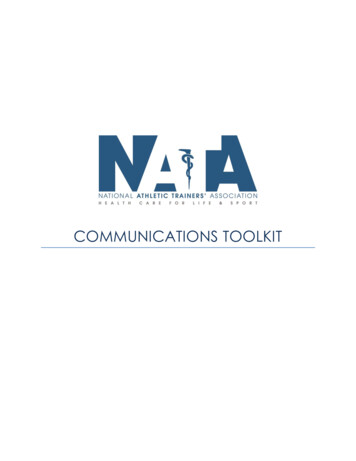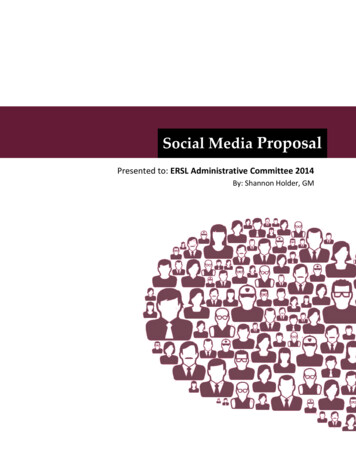
Transcription
Information Systems ySocial Media Adoption, Usage And Impact In Business-To-Business(B2B) Context: A State-Of-The-Art Literature ReviewYogesh K. Dwivedi 1 & Elvira Ismagilova 2 & Nripendra P. Rana 2 & Ramakrishnan Raman 3Accepted: 7 January 2021# The Author(s) 2021AbstractSocial media plays an important part in the digital transformation of businesses. This research provides a comprehensive analysisof the use of social media by business-to-business (B2B) companies. The current study focuses on the number of aspects of socialmedia such as the effect of social media, social media tools, social media use, adoption of social media use and its barriers, socialmedia strategies, and measuring the effectiveness of use of social media. This research provides a valuable synthesis of therelevant literature on social media in B2B context by analysing, performing weight analysis and discussing the key findings fromexisting research on social media. The findings of this study can be used as an informative framework on social media for both,academic and practitioners.Keywords Business-to-business . Digital transformation . Information systems . Literature review . Marketing . Social media1 IntroductionThe Internet has changed social communications and socialbehaviour, which lead to the development of new forms ofcommunication channels and platforms (Ismagilova et al.2017). Social media plays an important part in the digitaltransformation of businesses (Kunsman 2018). Digital transformation refers to the globally accelerated process of technical adaptation by companies and communities as a result ofdigitalisation (Sivarajah et al. 2019; Westerman et al. 2014).Web is developed from a tool used to provide passive information into the collaborative web, which allows and* Yogesh K. Dwivediykdwivedi@gmail.comElvira Ismagilovae.ismagilova@bradford.ac.ukNripendra P. Rananrananp@gmail.comRamakrishnan Ramandirector@sibmpune.edu.in1Emerging Markets Research Centre (EMaRC), School ofManagement, Swansea University, Bay Campus, Swansea, UK2School of Management, University of Bradford, Bradford, UK3Symbiosis Institute of Business Management, Pune & SymbiosisInternational, Deemed University, Pune, Indiaencourages active user engagement and contribution. If beforesocial networks were used to provide the information about acompany or brand, nowadays businesses use social media intheir marketing aims and strategies to improve consumers’involvement, relationship with customers and get useful consumers’ insights (Alalwan et al. 2017). Business-to-consumer(B2C) companies widely use social media as part of theirdigital transformation and enjoy its benefits such as an increase in sales, brand awareness, and customer engagementto name a few (Barreda et al. 2015; Chatterjee and Kar 2020;Harrigan et al. 2020; Kamboj et al. 2018; Kapoor et al. 2018).From a marketing and sales research perspective, socialmedia is defined as “the technological component of the communication, transaction and relationship building functions ofa business which leverages the network of customers andprospects to promote value co-creation” (Andzulis et al.2012 p.308). Industrial buyers use social media for their purchase as they compare products, research the market and buildrelationships with salesperson (Itani et al. 2017). Social mediachanged the way how buyers and sellers interact (Agnihotriet al. 2016) by enabling open and broad communications andcooperation between them (Rossmann and Stei 2015). Socialmedia is an important facilitator of relationships between acompany and customers (Agnihotri et al. 2012; Tedeschi2006). Customers are more connected to companies, whichmake them more knowledgable about product selection andmore powerful in buyer-seller relationships (Agnihotri et al.2016). Social media also helps companies to increase business
Inf Syst Frontexposure, traffic and providing marketplace insight (Agnihotriet al. 2016; Stelzner 2011). As a result, the use of social mediasupports business decision processes and helps to improvecompanies’ performance (Rossmann and Stei 2015).Due to digitalisation customers are becoming more informed and rely less on traditional selling initiatives(Ancillai et al. 2019). Buyers are relying more on digital resources and their buying process more often involves the useof social media. For example, in the research B2B buyer survey, 82% of buyers stated that social media content has asignificant impact on the purchase decision (Ancillai et al.2019; Minsky and Quesenberry 2016). As a result, thesechanges in consumer behaviour place high pressure on B2Bsalespeople and traditional sales companies (Ancillai et al.2019). By using evidence from major B2B companies andconsultancy report some studies claim that social media canbe applied in sales to establish effective dialogues with buyers(Ancillai et al. 2019; Kovac 2016; McKinsey and Company2015).Now, business-to-business (B2B) companies started usingsocial media as part of their digital transformation. 83% ofB2B companies use social media, which makes it the mostcommon marketing tactic (Pulizzi and Handley 2017; Sobal2017). More than 70% of B2B companies use at least one ofthe “big 4” social media sites such as LinkedIn, Twitter,Facebook and YouTube. Additionally, 50% of the companiesstated that social media has improved their marketing optimization and customer experience, while 25% stated that theirrevenue went up (Gregorio 2017; Sobal 2017). Even thoughB2B companies are benefitting from social media used bymarketers, it is argued that research on that area is still in theembryonic stage and future research is needed (Salo 2017;Siamagka et al. 2015; Juntunen et al. 2020; Iannacci et al.2020). There is a limited understanding of how B2B companies need to change to embrace recent technological innovations and how it can lead to business and societal transformation (Chen et al. 2012; Loebbecke and Picot 2015; Pappaset al. 2018).The topic of social media in the context of B2B companieshas started attracting attention from both academics and practitioners. This is evidenced by the growing number of researchoutput within academic journals and conference proceedings.Some studies provided a comprehensive literature review onsocial media use by B2B companies (Pascucci et al. 2018;Salo 2017), but focused only on adoption of social media byB2B or social media influence, without providing the wholepicture of the use of social media by B2B companies. Thus,this study aims to close this gap in the literature by conductinga comprehensive analysis of the use of social media by B2Bcompanies and discuss its role in the digital transformation ofB2B companies. The findings of this study can provide aninformative framework for research on social media in thecontext of B2B companies for academics and practitioners.The remaining sections of the study are organised as follows. Section 2 offers a brief overview of the methods used toidentify relevant studies to be included in this review.Section 3 synthesises the studies identified in the previoussection and provides a detailed overview. Section 4 presentsweight analysis and its findings. Next section discusses thekey aspects of the research, highlights any limitations withinexisting studies and explores the potential directions for futureresearch. Finally, the paper is concluded in Section 6.2 Literature Search MethodThe approach utilised in this study aligns with the recommendations in Webster and Watson (2002). This study used akeyword search-based approach for identifying relevant articles (Dwivedi et al. 2019b; Ismagilova et al. 2020a;Ismagilova et al. 2019; Jeyaraj and Dwivedi 2020; Williamset al. 2015). Keywords such as “Advertising” OR“Marketing” OR “Sales” AND TITLE (“Social Media” OR“Web 2.0” OR “Facebook” OR “LinkedIn” OR “Instagram”OR “Twitter” OR “Snapchat” OR “Pinterest” OR“WhatsApp” OR “Social Networking Sites”) AND TITLEABS-KEY (“B2B” OR “B to B” OR “Business to Business”OR “Business 2 Business”) were searched via the Scopusdatabase. Scopus database was chosen to ensure the inclusionof only high quality studies. Use of online databases forconducting a systematic literature review became an emergingculture used by a number of information systems researchstudies (Dwivedi et al. 2019a; Gupta et al. 2019; Ismagilovaet al. 2020b; Muhammad et al. 2018; Rana et al. 2019). Thesearch resulted in 80 articles. All studies were processed bythe authors in order to ensure relevance and that the researchoffered a contribution to the social media in the context B2Bdiscussion. The search and review resulted in 70 articles andconference papers that formed the literature review for thisstudy. The selected studies appeared in 33 separate journalsand conference proceedings, including journals such asIndustrial Marketing Management, Journal of Business andIndustrial Marketing and Journal of Business Research.3 Literature SynthesisThe studies on social media research in the context ofB2B companies were divided into the following themes:effect of social media, adoption of social media, socialmedia strategies, social media use, measuring the effectiveness of use of social media, and social media tools(see Table 1). The following subsections provide anoverview of each theme.
Inf Syst FrontTable 1 Themes in social mediaresearch (B2B context)ThemeSourcesEffect of social mediaAgnihotri et al. 2016; Ancillai et al. 2019; Rossmann and Stei 2015; Agnihotriet al. 2012; Agnihotri et al. 2017; Itani et al. 2017; Salo 2017; Bhattacharjyaand Ellison 2015; Gáti et al. 2018; Gruner and Power 2018; Hollebeek 2019;Iankova et al. 2018; Jussila et al. 2011; Kho 2008; Niedermeier et al. 2016;Ogilvie et al. 2018; Hsiao et al. 2020; Mahrous 2013; Kärkkäinen et al. 2011;Meire et al. 2017; Moncrief et al. 2015; Rodriguez et al. 2012; Pitt et al.2018; Pitt et al. 2017; Sivarajah et al. 2019Adoption of social mediaBuratti et al. 2018; Gáti et al. 2018; Gazal et al. 2016; Itani et al. 2017; Kumarand Möller 2018; Lacka and Chong 2016; Lashgari et al. 2018; Michaelidouet al. 2011; Müller et al. 2018; Nunan et al. 2018; Pascucci et al. 2018;Rossmann and Stei 2015; Shaltoni 2017; Siamagka et al. 2015; Wang et al.2017Social media strategiesCawsey and Rowley 2016; Huotari et al. 2015; Kasper et al. 2015; McShaneet al. 2019; Mudambi et al. 2019; Swani et al. 2013; Swani et al. 2014; Swaniet al. 2017; Watt 2010Social media useAndersson et al. 2013; Bernard 2016; Bolat et al. 2016; Denktaş-Şakar andSürücü 2018; Dyck 2010; Guesalaga 2016; Habibi et al. 2015; Katona andSarvary 2014; Moore et al. 2013; Moore et al. 2015; Müller et al. 2013;Niedermeier et al. 2016; Sułkowski and Kaczorowska-Spychalska 2016;Vasudevan and Kumar 2018; Vukanovic 2013Measuring effectiveness ofsocial mediaSocial media toolsGazal et al. 2016; Michaelidou et al. 2011; Vasudevan and Kumar 2018Keinänen and Kuivalainen 2015; Mehmet and Clarke 2016; Yang et al. 20123.1 Effect of Social Media3.1.1 Customer SatisfactionSome studies focus on the effect of social media for B2Bcompanies, which include customer satisfaction, value creation, intention to buy and sales, building relationships withcustomers, brand awareness, knowledge creation, perceivedcorporate credibility, acquiring of new customers, salespersonperformance, employee brand engagement, and sustainability(Table 2).Some studies investigated how the use of social media affected customer satisfaction (Agnihotri et al. 2016; Ancillai et al.2019; Rossmann and Stei 2015). For example, Agnihotri et al.(2016) investigated how the implementation of social mediaby B2B salesperson affects consumer satisfaction.Salesperson’s social media use is defined as a “salesperson’sutilization and integration of social media technology toTable 2Effect of social mediaThemeSource(s)Customer satisfactionAgnihotri et al. 2016; Ancillai et al. 2019; Rossmann and Stei 2015Value CreationAgnihotri et al. 2012; Agnihotri et al. 2017Intention to buy and SalesAncillai et al. 2019; Hsiao et al. 2020; Itani et al. 2017; Mahrous 2013; Salo 2017Customer relationshipsBhattacharjya and Ellison 2015; Gáti et al. 2018; Gruner and Power 2018;Hollebeek 2019; Iankova et al. 2018; Jussila et al. 2011; Kho 2008; Niedermeier et al. 2016; Ogilvie et al. 2018Brand awarenessAncillai et al. 2019; Hsiao et al. 2020Knowledge creationKärkkäinen et al. 2011Corporate credibilityAcquiring new customersKho 2008Meire et al. 2017Salesperson performanceMoncrief et al. 2015; Rodriguez et al. 2012Employee brand managementPitt et al. 2018; Pitt et al. 2017SustainabilitySivarajah et al. 2019; Kasper et al. 2015
Inf Syst Frontperform his or her job” (Agnihotri et al. 2016, p.2). The studyused data from 111 sales professionals involved in B2B industrial selling to test the proposed hypotheses. It was foundthat a salesperson’s use of social media will have a positiveeffect on information communication, which will, in turn, leadto improved customer satisfaction with the salesperson. Also,it was investigated that information communication will bepositively related to responsiveness, which impacts customersatisfaction.Another study by Rossmann and Stei (2015) looked at theantecedents of social media use, social media use by B2Bcompanies and their effect on customers. By using data from362 chief information officers of B2B companies the studyfound the following. Social media usage of sales representative has a positive impact on customer satisfaction. Age has anegative effect on content generation. It seems that older salespeople use social media in passive ways or interacting with thecustomer rather than creating their own content. It was foundthat the quality of corporate social media strategy has a positive impact on social media usage in terms of the consumptionof information, content generation, and active interaction withcustomers. Also, the expertise of a salesperson in the area ofsocial media has a positive impact on social media usage.3.1.2 Value CreationResearch in B2B found that social media can create value forcustomers and salesperson (Agnihotri et al. 2012; Agnihotriet al. 2017). Agnihotri et al. (2012) proposed a theoreticalframework to explain the mechanisms through which salespeople’s use of social media operates to create value and propose a strategic approach to social media use to achieve competitive goals. The study draws on the existing literature onrelationship marketing, task–technology fit theory, and salesservice behavior to sketch a social media strategy for businessto-business sales organizations with relational selling objectives. The proposed framework describes how social mediatools can help salespeople perform service behaviors(information sharing, customer service, and trust-building)leading to value creation.Some researchers investigated the role of the salesperson inthe value creation process after closing the sale. By employingsalesperson-customer data within a business-to-business context, Agnihotri et al. (2017) analysed the direct effects of salesbased CRM technology on the post-sale service behaviors:diligence, information communication, inducements, empathy, and sportsmanship. Additionally, the study examinesthe interactive effects of sales-based CRM technology andsocial media on these behaviors. The results indicate thatsales-based CRM technology has a positive influence onsalesperson service behaviors and that salespeople usingCRM technology in conjunction with social media are morelikely to exhibit higher levels of SSBs than their counterpartswith low social media technology use. Data were collectedfrom 162 salespeople from India. SmartPLS was used to analyse the data.3.1.3 Intention to Buy and SalesAnother group of studies investigated the effect of social media on the level of sales and consumer purchase intention(Ancillai et al. 2019; Itani et al. 2017; Salo 2017; Hsiaoet al. 2020; Mahrous 2013). For example, Itani et al. (2017)used the theory of reasoned actions to develop a model thattests the factors affecting the use of social media bysalesperson and its impact. By collecting data from 120salespersons from different industries and using SmartPLSto analyse the data, it was found that attitude towards socialmedia usefulness did not affect the use of social media. It wasfound that social media use positively affects competitiveintelligence collection, adaptive selling behaviour, which inturn influenced sales performance. Another study byAncillai et al. (2019) used in-depth interviews with socialselling professionals. The findings suggest that the use of social media improves not only the level of sales but also affectsrelationship and customer performance (trust, customer satisfaction, customer referrals); and organisational performance(organisational selling performance and brand performance).It was investigated that social media has a positive effect onthe intention to purchase (Hsiao et al. 2020; Mahrous 2013).For instance, Mahrous (2013) by reviewing the literature onB2B and B2C companies concluded that social media has asignificant influence on consumer buying behaviour.3.1.4 Customer RelationshipsAnother group of studies focused on the effect of social mediaon customer relationships (Bhattacharjya and Ellison 2015;Gáti et al. 2018; Gruner and Power 2018; Hollebeek 2019;Iankova et al. 2018; Jussila et al. 2011; Kho 2008;Niedermeier et al. 2016; Ogilvie et al. 2018). For example,Bhattacharjya and Ellison (2015) investigated the way companies build relationships with customers by using responsivecustomer relationship management. The study analysed customer relationship management activities from Twitter account of a Canadian company Shopify (B2B service provider). The company uses Twitter to engage with small businesscustomers, develops and consumers. Jussila et al. (2011), byreviewing the literature, found that social media leads to increased customer focus and understanding, increased level ofcustomer service and decreased time-to-market.Gáti et al. (2018) focused their research efforts on socialmedia use in customer relationship performance, particularlyin customer relations. The study investigated the adoption andimpact of social media by salespeople of B2B companies. Byusing data of 112 salespeople from several industries the study
Inf Syst Frontfound that the intensity of technology use positively affectsattitude towards social media, which positively affects socialmedia use. Intensive technology use in turn positively affectscustomer relationship performance (customer retention). PLSSEM was applied for analysis.Another study by Gruner and Power (2018) investigatedthe effectiveness of the use of multiple social media platformsin communications with customers. By using data from 208large Australian organisations, the paper explores how companies’ investment in one form of social media impacts activity on another form of social media. A regression analysis wasperformed to analyse the data. It was found that widespreadactivities on LinkedIn, Twitter and YouTube have a negativeeffect on a company’s marketing activity on Facebook. Thus,having it is more effective for the company to focus on aspecific social media platform in forming successful interorganisational relationships with customers.Hollebeek (2019) proposed an integrative S-D logic/resource-based view (RBV) model of customer engagement.The proposed model considers business customer actors andresources in driving business customer resource integration,business customer resource integration effectiveness and business customer resource integration efficiency, which are antecedents of business customer engagement. Business customerengagement, in turn, results in business customer co-creationand relationship productivity.Niedermeier et al. (2016) investigated the use of socialmedia among salespeople in the pharmaceutical industry inChina. Also, the study investigated the impact of social mediaon building culturally specific Guanxi relationships-it involves the exchange of factors to build trust and connectionfor business purpose. By using in-depth interviews with 3sales managers and a survey of 42 pharmaceutical sales representatives that study found that WeChat is the most commonsocial media platform used by businesses. Also, it was foundto be an important tool in building Guanxi. Future studiesshould focus on other industries and other types of culturalfeatures in doing business.Ogilvie et al. (2018) investigated the effect of social mediatechnologies on customer relationship performance and objective sales performance by using two empirical studies conducted in the United States. The first study used 375 salespeople from 1200 B2B companies. The second study used 181respondents from the energy solution company. It was foundthat social media significantly affects salesperson product information communication, diligence, product knowledge andadaptability, which in turn affect customer relationship performance. It was also found that the use of social media technologies without training on technology will not lead to goodresults. Thus, the results propose that companies should allocate the resources required for the proper implementation ofsocial media strategies. Future research should examine howthe personality traits of a salesperson can moderate the implementation of social media technologies.While most of the studies focused on a single country,Iankova et al. (2018) investigated the perceived effectivenessof social media by different types of businesses in two countries. By using 449 respondents from the US and the UKbusinesses, it was found that social media is potentially lessimportant, at the present time, for managing ongoing relationships in B2B organizations than for B2C, Mixed or B2B2Corganizations. All types of businesses ascribe similar importance to social media for acquisition-related activities. Also itwas found that B2B organizations see social media as a lesseffective communication channel, and to have less potential asa channel for the business.3.1.5 Brand AwarenessSome researchers argued that social media can influencebrand awareness (Ancillai et al. 2019; Hsiao et al. 2020).For instance, Hsiao et al. (2020) investigated the effect ofsocial media in the fashion industry. By collecting 1395 postsfrom lookbook.nu and employing regression analysis it wasfound that the inclusion of national brand and private fashionbrands in the post increased the level of popularity which leadsto purchasing interest and brand awareness.3.1.6 Knowledge CreationMultiple types of collaborative web tools can help and significantly increase the collaboration and the use of the distributedknowledge inside and outside of the company (McAfee2006). Kärkkäinen et al. (2011) by analysing previous literature on social media proposed that social media use has apositive effect on sharing and creation of customer information and knowledge in the case of B2B companies.3.1.7 Corporate CredibilityAnother study by Kho (2008) states the advantages of usingsocial media by B2B companies, which include faster andmore personalised communications between customer andvendor, which can improve corporate credibility andstrengthen the relationships. Thanks to social mediacompanies can provide more detailed information abouttheir products and services. Kho (2008) also mentions thatcustomer forums and blog comments in the B2B environmentshould be carefully monitored in order to make sure that inappropriate discussions are taken offline and negative eWOMcommunications should be addressed in a timely manner.
Inf Syst Front3.1.8 Acquiring New CustomersMeire et al. (2017) investigated the impact of social media onacquiring B2B customers. By using commercially purchasedprospecting data, website data and Facebook data from beverage companies the study conducted an experiment andfound that social media us an effective tool in acquiringB2B customers. Future work might assess the added valueof social media pages for profitability prediction instead ofprospect conversion. When a longer timeframe becomesavailable (e.g., after one year), the profitability of the converted prospects can be assessed.3.1.9 Salesperson PerformanceMoncrief et al. (2015) investigated the impact of social mediatechnologies on the role of salesperson position. It was foundthat social media affects sales management functions (supervision, selection, training, compensation, and deployment)and salesperson performance (role, skill, and motivation).Another study by Rodriguez et al. (2012) examines the effectof social media on B2B sales performance by using socialcapital theory and collecting data from 1699 B2B salespeoplefrom over 25 different industries. By employing SEM AMOS,the study found that social media usage has a positive significant relationship with selling companies’ ability to create opportunities and manage relationships. The study also foundthat social media usage has a positive and significant relationship with sales performance (based on relational measurers ofsales that focus on behaviours that strengthen the relationshipbetween buyers and sellers), but not with outcome-based salesperformance (reflected by quota achievement, growth in average billing size, and overall revenue gain).3.1.10 Employee Brand ManagementThe study by Pitt et al. (2018) focuses on employee engagement with B2B companies on social media. By using resultsfrom Glassdoor (2315 five-star and 1983 one-star reviews forthe highest-ranked firms, and 1013 five star and 1025 one-starreviews for lowest ranked firms) on employee brand engagement on social media, two key drivers of employee brandengagement by using the content analysis tool DICTION wereidentified-optimism and commonality. Individuals working intop-ranked companies expressed a higher level of optimismand commonality in comparison with individuals working inlow-ranked companies. As a result, a 2 2 matrix was constructed which can help managers to choose strategies in orderto increase and improve employee brand engagement.Another study by Pitt et al. (2017) focused on employee engagement of B2B companies on social media. By using aconceptual framework based on a theory of word choice andverbal tone and 6300 reviews collected from Glassdoor andanalysed using DICTION. The study found that employees ofhighly ranked B2B companies are more positive about theiremployer brand and talk more optimistically about thesebrands. For low ranked B2B companies it was found thatemployees express a greater level of activity, certainty, andrealism. Also, it was found that they used more aggressivelanguage.3.1.11 SustainabilitySustainability refers to the strategy that helps a business “tomeet its current requirements without compromising its abilityto meet future needs” (World Commission Report onEnvironment and Development 1987, p 41). Two studies outof 70 focused on the role of social media for B2B sustainability (Sivarajah et al. 2019; Kasper et al. 2015). For example,Sivarajah et al. (2019) argued that big data and social mediawithin a participatory web environment to enable B2B organisations to become profitable and remain sustainable throughstrategic operations and marketing related business activities.Another study by Kasper et al. (2015) proposed the SocialMedia Matrix which helps companies to decide which socialmedia activities to execute based on their corporate and communication goals. The matrix includes three parts. The firstpart is focusing on social media goals and task areas, whichwere identified and matched. The second part consists of fivetypes of social media activities (content, interaction/dialog,listening and analysing, application and networking). Thethird part provides a structure to assess the suitability of eachactivity type on each social media platform for each goal. Thematrix was successfully tested by assessing the German B2Bsector by using expert interviews with practitioners.Based on the reviewed studies, it can be seen that if usedappropriately social media have positive effect on B2B companies before and after sales, such as customer satisfaction,value creation, intention to buy and sales, customer relationships, brand awareness, knowledge creation, corporate credibility, acquiring new customers, salesperson performance,employee brand management, and sustainability. However,limited research is done on the negative effect of social mediaon b2b companies.3.2 Adoption of Social MediaSome scholars investigated factors affecting the adoption ofsocial media by B2B companies (Buratti et al. 2018; Gáti et al.2018; Gazal et al. 2016; Itani et al. 2017; Kumar and Möller2018; Lacka and Chong 2016). For instance, Lacka andChong (2016) investigated factors affecting the adoption ofsocial media by B2B companies from different industries inChina. The study collected the data from 181 respondents andused the technology acceptance model with Nielsen’s modelof attributes of system acceptability as a theoretical
Inf Syst Frontframework. By using SEM AMOS for analysis the studyfound that perceived usability, perceived usefulness, and perceived utility positively affect adoption and use of social media by B2B marketing professionals. The usefulness is subjectto the assessment of whether social media sites are suitablemeans through which marketing activities can be conducted.The ability to use social media sites for B2B marketing purposes, in turn, is due to those sites learnability and memorability attributes.Another study by Müller et al. (2018) investigated factorsaffecting the usage of social media. By using survey data from100 Polish and 39 German sensor suppliers, it was found thatbuying frequency, the function of a buyer, the industry sectorand the country does not affect the usage of social media in thecontext of sensor technology from Poland and Germany. Thestudy used correlation analysis and ANOVA.L
Social Media Adoption, Usage And Impact In Business-To-Business (B2B) Context: A State-Of-The-Art Literature Review Yogesh K. Dwivedi1 & Elvira Ismagilova2 & Nripendra P.


